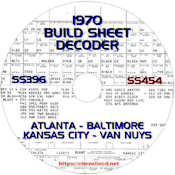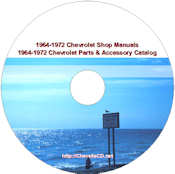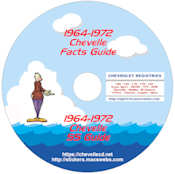ChevelleWorld
How Chevelles Were Built
In this era, Fisher Body and Chevrolet were two separate entities although they often shared the same plant; Fisher Body on one side and Chevrolet on the other. When a dealer's order came in a notification was sent to both companies to set in motion the building of the car in two parts - Fisher Body would build the car from the firewall to the tail lamps while Chevrolet would build the front sheet metal, chassis, and running gear. Fisher Body would transport the finished body to what was referred to as a 'body bank' where the bodies would set until they were moved to the Chevrolet side of the plant. At this point the Fisher Body number plate would be affixed to the firewall with Fisher Body's body number.
When Chevrolet had the chassis, running gear, etc. in inventory, the body would be pushed or loaded on a conveyor and moved to the Chevrolet side of the plant and the two would be 'married' at some point in the final assembly process, For a dealer's stock, this would normally result in body number for a particular series and body style to match up with the chassis, running gear, etc. from Chevrolet and VINs would be assigned accordingly.
Often if a Chevelle was for a customer order, it would take priority in production. This might result in a later (higher) body number being used on a lower VIN sequence Chevelle of the same series and body style. If a body had an issue that needed repair it might be pulled from the schedule resulting in an later VIN sequence.
Another cause could be the availability of some options not being in inventory causing Chevrolet to have to wait on the next shipment of parts to complete the build. You will sometimes find some major assemblies like particular engines, transmissions, or rear ends have vastly different build dates for those parts finding their way to a particular car. Typically the major components will have a date within a few days of each other. It is generally accepted that these major components could be as much as three months prior to the car's assembly date, sometimes longer. Why? GM's inventory control was built on the premise of having correct parts for a build with Just-In-Time inventory to keep in-house inventory to a minimum. Often a build shipment of a popular component, say a 283-2bbl engine, could be racked and used ahead of a remaining inventory of the same engine and the newer dated engines being installed ahead of those earlier built engines still in inventory, resulting in, say, a mid-March-built Malibu having a 'newer' dated engine than a late March-built Malibu.
Say you saw it here on © ChevelleWorld




Want more in-depth information on 1964-1972 Chevelles? My 1970 SS 396/SS454
Build Sheet Decode Program CD, Shop Manuals & Parts Catalog program DVD, Facts and SS
Guide program CD, and 1964-1972 Trim Tag and Protect-O-Plate program CD. Check
them and other informative program CDs at my
https://chevellecd.net website.

 1964 Chevelle
1964 Chevelle 1965 Chevelle
1965 Chevelle 1966 Chevelle
1966 Chevelle 1967 Chevelle
1967 Chevelle 1968 Chevelle
1968 Chevelle 1969 Chevelle
1969 Chevelle 1970 Chevelle
1970 Chevelle 1971 Chevelle
1971 Chevelle 1972 Chevelle
1972 Chevelle


